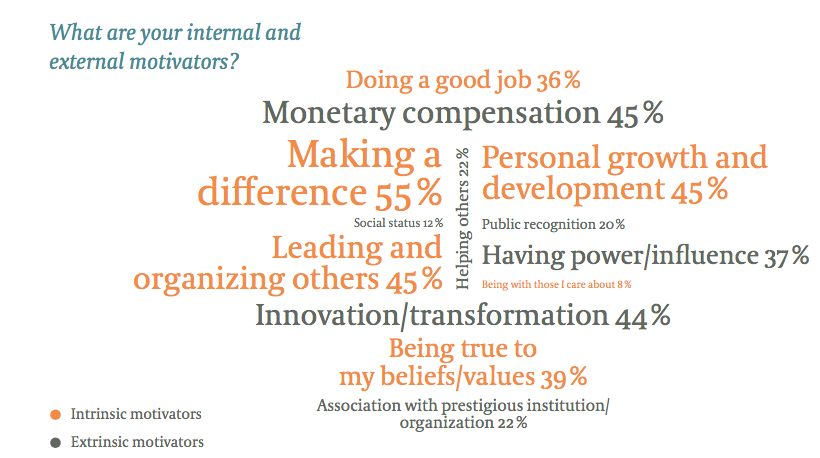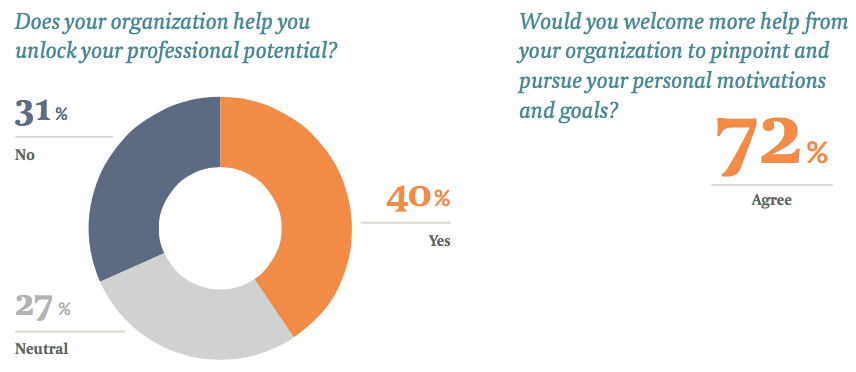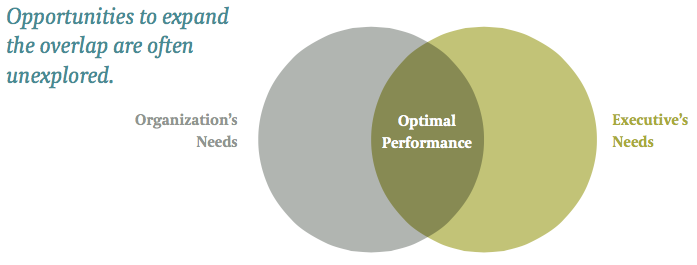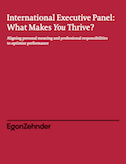International Executive Panel: What Makes You Thrive?
Aligning personal meaning and professional responsibilities to optimize performance
Summary of findings
There is mounting evidence that the relationship between an executive’s personal goals and priorities – a person’s identity – and his or her career path greatly affects performance. However, this alignment is given little attention by either executives or enterprises. Addressing this issue presents an important opportunity for organizations to increase the performance and retention of key executives, and for executives to derive deeper satisfaction and meaning from their work.
To help provide insight into this issue, in the fall of 2015 Egon Zehnder surveyed 1,275 senior executives from around the world on their personal priorities and the extent to which those executives felt those priorities were supported at work. The key findings were consistent across industries and regions and provide a framework for thinking about ways of increasing alignment between personal meaning and one’s professional environment. The complete set of questions and responses can be found in the Appendix.
A range of motivations
Our survey showed that senior executives are driven by a variety of internal motivators (including the opportunity to make a difference, to lead others and to undergo personal growth) and external motivators (such as compensation, the opportunity to be part of an innovative enterprise and having power and influence). The wide range of motivations among leaders is underscored by the fact that no single factor was chosen by much more than half the respondents (see Figure 1).

Figure 1
Importantly, the fact that executives are motivated by many factors increases the possibilities for misalignment when employees and executives communicate. For example, organizations tend to emphasize external motivators in how they present opportunities to executives. While it is true that executives value rewards such as compensation, they also value internal motivators. External motivators do not play as large a factor in executive decision-making as many organizations believe.
Searching for a direction other than up
The overwhelming majority (70 percent) of executives we surveyed feel that too much emphasis is placed on moving up the organizational chart when lateral moves should also be held in esteem (see Figure 2). This is echoed by the finding that only 31 percent of respondents believe their organization has effective ways to reward high performance other than promotion.

Figure 2
If we consider this finding against our experience in the field, we see that on a practical level, “moving up the ranks” often means two things:
- Focusing on short-term performance metrics and “checking the boxes”: This focus prevents executives from shaping the role in a way that satisfies both company objectives and the individual’s own priorities.
- Relocating to take roles dictated by a professional development plan: It is difficult to overstate how disruptive successive relocations are to mid-career and senior executives with families. But those who decline find that their careers stagnate. Executives also frequently feel that the rationale for these moves is not sufficiently explained to them.
An opportunity to connect
When asked if their organization helps them unlock their potential, 60 percent of respondents were neutral or negative. An even larger number (72 percent) would welcome more help from their organization to pinpoint and pursue their personal motivations and goals (see Figure 3).

Figure 3
These findings suggest that a great many executives see an opportunity for a closer alignment of their job and their essential identity and priorities. Some might even feel a clear disconnect. And yet we would also observe an interesting paradox: Few executives who feel that disconnect proactively take steps to address the situation by, for example, working to articulate their personal goals in a way that aligns with company objectives, or by fully exploring the potential of their current role. Instead, they often feel that their only option is to search for an opportunity elsewhere.
Conclusions: Rethinking assumptions about the talent market
Organizations and executives represent the two sides of the talent market, and each side comes to the table with its own expectations and requirements. In recent years, executives evaluating their current position (or an opportunity elsewhere) have begun to place a greater weight on personal fulfillment and alignment with values. However, many of the mechanisms and assumptions that drive the talent market have failed to keep pace with these changes.
For example, at many companies, even at very senior levels, professional development is essentially a one-way conversation – with the human resources department dictating what trajectory a given executive should follow, the competencies that need to be acquired and the weaknesses that need to
be addressed. That disconnect is deepened as organizations present opportunities in terms of external motivators and judge performance primarily based on quantitative metrics rather than intangible, but still important, benchmarks.
However, the current impasse – in which only 40 percent of executives feel that their organizations help them unlock their professional potential – is not only the responsibility of the organization. Executives have adapted to organization-driven professional development by internalizing a binary “take it or leave it” attitude toward the opportunities they are presented. While it remains a fact of life that organizations do not exist purely for the professional development of their employees, we feel there is significant overlap of interests that remains unexplored by both sides.
Indeed, the intersection between the needs of the organization and the needs of the executive is where optimal performance – the goal of both sides – takes place. The path forward, then, is for organizations and executives to increase the size of that common ground. We offer the following suggestions to help do so:

Figure 4
Organizations
- Professional development should go beyond mere box-checking and become a true dialogue between the organization and the executive
- The rationale behind proposed moves could be better communicated
- Additional ways to develop executives who decline traditional promotion tracks should be created
- Metrics of success need to expand their emphasis beyond the traditional quantitative measures
Executives
- Executives should take more ownership of their own growth and trajectory and be forthright in discussing their goals with the organization
- Executives could improve their awareness and understanding of their own personal priorities, how they intersect with those of the organization – and how they both change over time
- Executives should take accountability for shaping current roles to maximize alignment with their interests and priorities
There is a pervasive unspoken assumption that professional development should be focused on a single goal: preparing executives to move up the chain of command. But human motivation is not so homogeneous – leaders are driven by a wide range of factors. Organizations that can engage senior executives in genuine dialogue about their personal aspirations and develop multiple paths for recognition and progress can fully engage their leadership and become role models in the quest for more authentic workplaces.
We hope the findings and perspectives presented in the Egon Zehnder International Executive Panel on Identity provides a framework for strengthening the interaction between organizations and executives regarding these critical underlying issues. We welcome the opportunity to discuss these findings with you.






